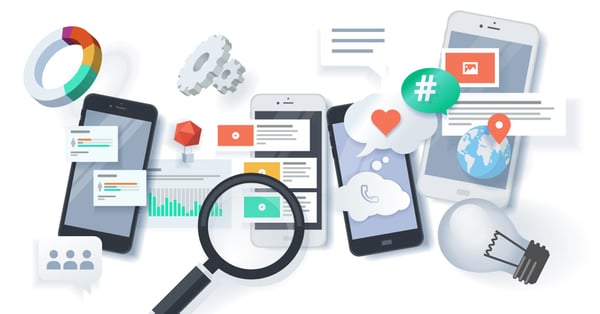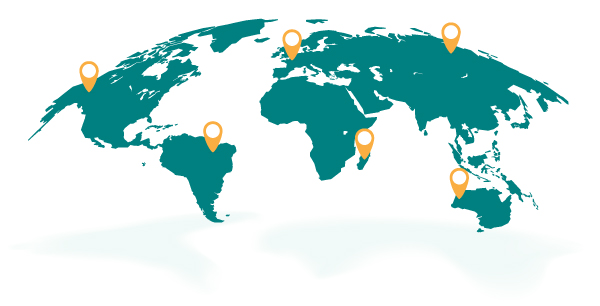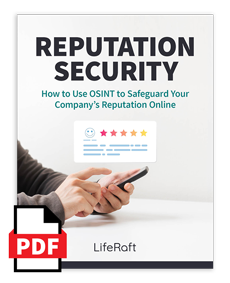If you follow the news, it’s hard to go for more than a few days without hearing about another incident of brandjacking.
The practice thrives online. With a few clicks of the mouse, anyone can register a domain, design a website, or create a social media account that resembles a legitimate business. And by exploiting the reputations of trusted companies, scammers can more easily separate the public from their money.
But when customers start looking for someone to blame for their losses, it’s unlikely the genuine firm will walk away unscathed. Brandjacking not only steals sales that would otherwise go to a legitimate business. But consumers that have fallen victim to such schemes are likely to switch to a competitor that is seen as more trustworthy.
So how can you protect your organization? Let's break down seven techniques security teams can use to safeguard their business from brandjacking.
Learn More: How to Use OSINT to Safeguard Your Company’s Reputation Online
What is Brandjacking?
Brandjacking refers to a collection of tactics where a person or company assumes the identity of an unaffiliated, legitimate brand. Some common examples include creating social media accounts that mimic established companies, selling counterfeit products designed to look like the real thing, or registering domains with deliberately misspelled names of well-known websites. Typically the individuals behind such brandjacking schemes conduct these activities to deceive consumers into buying counterfeit goods or divulging personal information.
Such attacks have real consequences for businesses. Brandjacking can damage an organization’s reputation, confuse customers, and bite into sales. Over the long term, the unauthorized use of a company's name or logo can also dilute the strength of the brand. That makes it harder for the firm to control its image and message, potentially undermining its competitive advantage in the marketplace.
Trademark your brand name and logo
 Trademarking a name and logo represents one of the first steps any organization should take to protect themselves from brandjacking. This legally safeguards your trademark from being used without your permission and gives you the right to take legal action against anyone who infringes on your brand. To complete this process, you'll need to work with a trademark attorney and follow the application procedure outlined in your jurisdiction.
Trademarking a name and logo represents one of the first steps any organization should take to protect themselves from brandjacking. This legally safeguards your trademark from being used without your permission and gives you the right to take legal action against anyone who infringes on your brand. To complete this process, you'll need to work with a trademark attorney and follow the application procedure outlined in your jurisdiction.
Monitor mentions of your brand online
Cases of brandjacking occur increasingly online. That’s why it's critical to monitor the web for mentions of your organization. That can include surveilling websites and social media platforms for unauthorized use of your brand's name, logo, or products.
If you come across cases of brand abuse, your team must respond quickly. On-site reporting tools serve as a vital resource for removing bad actors on social media. In other cases, investigators may have to contact the responsible party directly. If the abuse continues, you may need to take legal action.
Keep tabs on emerging alt-tech social networks
 Most companies already conduct web surveillance on the largest social media platforms (i.e. Reddit, Facebook, Instagram, etc.). Increasingly, however, bad actors have migrated to lesser-known, alt-tech social networks that promise less moderation and fewer restrictions on speech. Unfortunately, few businesses keep tabs on these communities. And in many cases, these new sites have emerged as havens for counterfeit goods and other types of brandjacking. For that reason, security teams shouldn’t overlook alt-tech social networks in their web monitoring efforts.
Most companies already conduct web surveillance on the largest social media platforms (i.e. Reddit, Facebook, Instagram, etc.). Increasingly, however, bad actors have migrated to lesser-known, alt-tech social networks that promise less moderation and fewer restrictions on speech. Unfortunately, few businesses keep tabs on these communities. And in many cases, these new sites have emerged as havens for counterfeit goods and other types of brandjacking. For that reason, security teams shouldn’t overlook alt-tech social networks in their web monitoring efforts.
Exploit web monitoring tools
Manual web monitoring is a common practice among security teams. But employing analysts to troll through forums and social media represents a time-consuming process. And few companies, even the largest enterprises, have enough resources to conduct this type of surveillance effectively. As a result, organizations can overlook many instances of brandjacking, putting their firm's reputation in jeopardy.
To overcome this issue, consider investing in web monitoring tools to automate routine tasks. For security leaders, these technologies represent a force multiplier, allowing organizations to stretch limited budgets. For analysts, monitoring tools allow teams to watch wider segments of the web, reducing the chance they will overlook a critical threat. These technologies also free up time for teams to focus on investigation and case resolution, rather than manually searching through web forums or social media posts.
Educate your customers about brand abuse
Take steps to educate your customers about brand abuse. For example, this could include detailed information about how to spot counterfeit products, fake web pages, or account impersonations. These measures will go a long way toward protecting your customers from being victimized by fraudsters.
Don’t overlook brand abuse in different languages or regions
 When conducting web surveillance, analysts tend to focus on their native tongue. And for most U.S. businesses, that means conducting queries and searches primarily in English. Unfortunately, most cases of brandjacking occur in other languages analysts often overlook.
When conducting web surveillance, analysts tend to focus on their native tongue. And for most U.S. businesses, that means conducting queries and searches primarily in English. Unfortunately, most cases of brandjacking occur in other languages analysts often overlook.
If you’re tackling issues like counterfeiting and content piracy, for instance, it is crucial to expand your search beyond just your first language. Instead of solely searching for your company's normal product names or descriptions, use translation tools to check for brand infringement in other communities.
Additionally, consider locations beyond where your company and distributors normally operate. For example, even if your firm conducts business mostly in the U.S., it often pays to monitor online marketplaces in regions such as Asia, Africa, and South America.
Collaborate with partners
Working with partners represents another key step in protecting your brand. This can include collaborating with local and national law enforcement agencies to crack down on counterfeiters and other parties engaged in brand abuse. Industry associations and trade groups can also help raise awareness about the issue and advocate for stronger laws to protect brands. By sharing information, businesses can become much more effective at putting an end to brandjacking than if they each work alone.
Additionally, corporate security teams should also leverage internal stakeholders within their organization. For example, marketing teams can help security teams to monitor online activity related to a company's brand, including social media channels and websites, to detect and mitigate brand abuse. Human resources can assist in developing employee training programs to educate staff on how to recognize and report potential brandjacking attempts. By working collaboratively, different silos can develop a proactive approach to prevent brandjacking, protecting a company's reputation and customer trust.
The bottom line on brandjacking
Brandjacking represents a growing headache for businesses. To address this problem, leaders must make this threat a bigger priority in their security strategy. But implementing some of the steps listed above will go a long way towards safeguarding your organization's brand and reputation.

